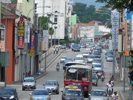|
SYNOPSIS
Ipoh Malay or Melayu Ipoh is a segment of unique Malay community in Malaysia.
They live as a minority in a Chinese dominated city , Ipoh
, the administration centre for Malay State of Perak since 1884. For over 200 years, the early Mendeling from Sumatra reign the territory before the mass influx of Chinese immigrant
change the landscape forever.
THE GREAT JOURNEY
Ipoh
was opened to the world by Dato Panglima Kulup Kinta, a Mendeling Malay,
a Muslim and originated from Sumatra in early 1650s. He navigate Kinta
River from Perak River and end up at small waterfalls near Gunung Cheroh that stop him from encroaching
upper. Mistically, he met a genie that told him to stop until that point. The place now stands the largest Hindu Temple of
Ipoh.
Orang
Asli
When he reach the valley, the
Kampong Ipoh has already existed and inhabited by orang Hulu, today called Orang Asli. This place then turned into Malay tin
mining area, a source that traded at Teluk Mak Intan, the today Teluk Intan, a hundred km river distance away. A
quote from a book written by Khoo Salma Nasution stated :
" So peculiarly is Kinta a mining district,
that even the Sakais of the hills do a little mining to get some tin and wherewith to buy the choppers and sarongs which the
Malays sell to them at an exorbitant price. (1) (Abraham Hale 1870s) "
Kampong Paloh Opened
This Malays later opened Kampong Paluh or 'muddy swampy
village', a few yards away from Kampong Ipoh. In early 1800s the settlement grew bigger which formed Kampong Kuala Pari and
Kampong Java. At the end of Malay domination, Kampong Manjoi opened, at the same period of British arrival and later
turned as occupiers, reach the heavenly tin valley, and brought in Chinese labor for tin mines.
" Malays prefer mountain mines
called "lampang". These workings are situated near a stream or torrent which provide the necessary water to wash the earth.
It consists of one or several narrow trenches, parallel to the stream and joined to it at both ends so that one can get a
certain volume of water. The trench is widened little by little and the earth is simply thrown to the bottom; the current,
operating a natural washing process, carries away the light parts. From time to time, the valuable deposits are scooped out
and undergo a final washing process on a flat surface. This mechanical process is rather easy, owing to the size of tin grains,
more abundant on mountain-sides than in the plains. Hence, this "lampang" method is considerably more productive when miners
have the good fortune to find a rich area. In these operations, 5 or 6 Malays enter into a partnership, rarely more. (5) (De
la Croix, 1881)"

Image from Khoo Salma Nasution archives
CHINESE MASSIVE ENTRANCE
Chinese Begin
Not long before the mass destruction of Ipoh natural landscape
in the hands of opportunist miners, the Brits shooed the opposive Sultan Abdullah to Seychelles Island and promotes the designed
Sultan Yusuf administration. Perak State
later grew prosperous when tin mining became the main income via international trading. The more mining land opened,
the more Chinese migrated to enslave themselves in a mining toil.
Chinese Stopped
Until the control of migration excersice introduced in
1931, Ipoh have 70,000 lives, with Chinese dominated 85% of
its population. The Malays shockly facing the massive change that turned them into the minority section of settler.
The vast increment of population for straight 60 years is believed at 20% a year. Ipoh was the second Chinese harbour
in Malay ruling states after Kuala Lumpur. In fact, in 1931, Kuala Lumpur hosting lesser than 60,000 inhabitants.
A Town Was Born
By the changes, Ipoh was
administrated by Town Council that even started earlier as a sanitary board that strightly involved in early
township planning. Loads of investment hop in even HSBC was opened in 1909 as the first in Malaya
near Ipoh Field. The Chinese traders occupied councils buildings with some are still at killing low monthly rentals.
MALAY EMIGRATION
Malay Effluence
When the Chinese had turned Ipoh
into a chinatown, more Malays migrate into rural areas nearby namely Sungai Siput, Parit
and Kuala Kangsar, simultaneous with the development of British initiated roadways and railroading. The number of Malays in
Ipoh dropped drastically and the Chinese dominated shops,
mines, cultivation land and caves. Still the remain, some die hard pioneers generation living in Manjoi, Kampong Paloh,
Kampong Java, Kuala Pari and Pasir Puteh.
Royalties Rule
For hundreds years, the Java and Sumatra
landlord had to deal with the situation that that there is a Sultan administration officers to rate their
activities. Each District had its governor appointed by Sultan and thus they are the Kings tongue and hands. By the year
1930s, the appointed Panglima Kinta (Duke of Kinta), Datuk C.M. Yussuf, has the opportunity to initiate a first ever bus service
from Ipoh old town to Gopeng. Although the place of strange
race has formed, the British liaison with Sultan has helped Malays to remain as the first occupier.
WORLD WAR II AND THE CIRCAS
Japanese Occupation
During this era, tens of architectural buildings with western
and middle-eastern design is already built. The Japanese stationed at various grand buildings as St. Michael Institution,
the railway station, Anderson School
as their operation offices. As we knows, this age of eastererly rule, Chinese turned to be victim of the Japs for
their support to China during China-Japan War years before. Chinese villages ragefully set ablazed by the Japanese
Army.
The
Communist Terrorist
As theres no specific death of Malays in Ipoh, the national figure for person killed during the 14 days communist rules in 1948 is
around 3,000. The chaotic 14 days of ruling lit an opportunity for the Communist Party of Malaya turns Malay for
revenge. Scholars, village cheifs, imams, penghulus was the target of their brutality. They have been slaughtered, shot
at point blank, decapitated and the entire family erased, for the things they ought to do as the rule enforcer. The brutality remains
as an unforgotten mark for even the younger generation of Malays who knew the story well. On that fateful period,
the British, for their way to retain their Queens territory, gave supports on war against
communist that they have armed few years back. From then on, the Malay Armed Forced held responsiblity in fighting the guerillas to
the day of abolishment of communist threat by December 1989.
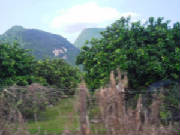
Once a black area, now a pomelo producer
POST INDEPENDENCE
The May 13, 1969
There is alot of stories told by veterans about things happened
during that fateful day in Ipoh. One is about a Malay
lady who are pregnant, being cut open with the carriage dropped on the floor in Canning Garden market. But thats an aural
without fact. The Kuala Lumpur riots believed started in Penang but yet to know what happened
here in Ipoh.
Remalaynization
As a response to third PM, Tun Razak campaign in upgrading
the urban Malay, the town council moves to bring back Malays into the town as early as 1975. Numerous low cost housing
estates built. More and more Malays especially the civil retirees bought houses and lands in Ipoh and this turned to be the
mass majority of Ipoh Malay today.
The Tin Turmoil
In early 1980s, the whole world experienced a tin price decrement.
As the leading tin producer with commodities above the Bolivia
that are the second, Kinta district doomed with slow progress. Ipoh
lagged behind since it industrial moves affected with the fact that the town is the most remote from the sea.
IPOH TODAY
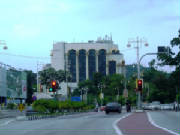
Formerly Douglas Roundabout
However, Ipoh still remains cool and calm without high volume traffic and high rise buildings.
The society now is well suit interracial network but still in a major segregation. Few Malays understand Cantonese and
there is tens if not hundreds Chinese that understand the fast spoken local Malay dialect. Ipoh
remains neat and tidy with highly energized flows of Kinta River turns the drainage dry and thus, the eyesores of seaside towns alike is almost
invisible, plus, without cat-size rats.

Ipoh
Parade
STORY ARE BASED ON RESEARCH THAT NEVER STAND AS THE VOICE OF PLURAL MALAY ORIGINS OF IPOH.
|
 |
 |
 |
Gog Magog are here now!
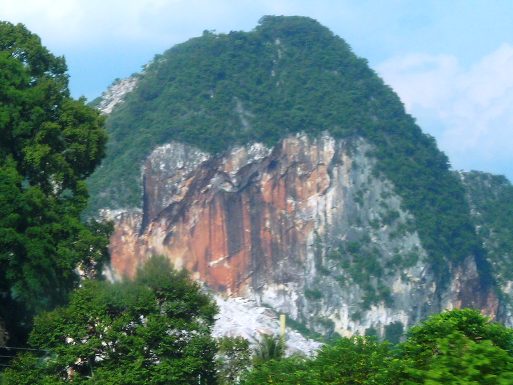
Simpang
Pulai
It
is prophesized that at the end age, Gog and Magog will exist to create a lot of devastation by its hands. Not spared, the
hills. In Simpang Pulai, limestone hills been carved down with explosive maneuver in the pulse of greediness. From some reliable
sources, the state government allocates some of million years gorgeously stood hills to the hands of the Gog Magog agent to
wipe it off the map. Scars of these hills are everywhere and became a notable eyesore for the passerbies that use the PLUS
highway within the hills.
Bullet train for
elites?
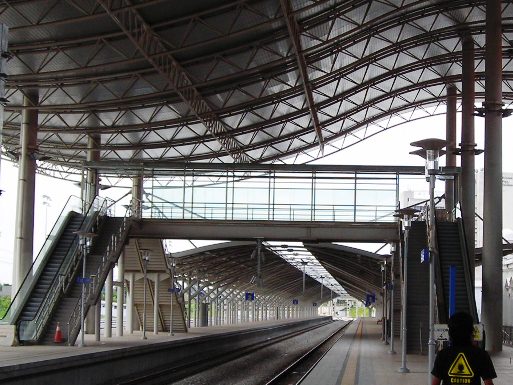
Ipoh
Railway Station
The
KTMB project for the electrified realigned double track from Rawang to Ipoh is now at the level of almost completed. Both structural
work for the track and the buildings are now in a finishing process. This project probably is the costliest project ever done
by the Federal Government in term of time and expenses.

Ipoh
Railway Station
The
project started in 2000 is now in the 7th year progress. It is believed that the shuttle train service that halves
the driving hour will be not as affordable as it was to the lower income groups that much more in needs of public transportation
efficiency. Even there is no immediate announcement of the introducing fare, it is believed that it will cost no lower than
RM40 for a single journey to KL.
Sunway : No Malay Area!
It is famously known that Sunway City offers a luxurious lifestyle in
a modern urban ambience. Sunway City Ipoh rapidly developed since 2002 and know became a host of six digits ringgit of houses.
Situated in Tambun parliament constituency which some 62% of the population is Malay, it is hardly to find any Malay that
willing to buy houses in Sunway City Ipoh.
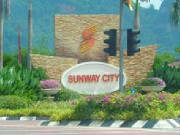
Sunway City
This is not because of the price, but this is a phenomenon that
has something to do with the direction of the marketing target. It is believed that this formerly communist terrorist
territory long time ago will stand as an exclusive no-Malay zone township that will be surrounded by Malay
settlements i.e Batu 5, Batu 6, Taman Perpaduan and Taman Mewah. Early this year, Sunway
City became a hotspot for nightclubbers when they opened Rum Jungle disco
within The Lost World of Tambun theme park. The menace will be dwarfed by an under-construction 5 star luxurious health spa
in caves the will be a potential hottest spot for vice activities in the city.
Ampang-Jelapang Link
The
controversial Jelapang toll booths and the scenic Ipoh Selatan tolls will no longer exist near future.
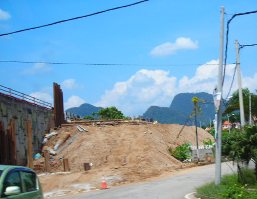
The
PLUS project in Tambun
The
highway flows will no longer obstructed in Ipoh and this cost
the Federal Government some RM260million to build a parallel road next to the highway to cater the needs of Ipohite that used
the toll-free highway to reach the other part of the valley since 1984. This under construction road will double fold the
distance accessed by Ipohite before when its designed to link Ampang and Jelapang.
Hundred Year Degrade
Tanjong Rambutan is a Malay village that historicly
opened by migrated Malay from the Upper Perak in Lenggong and Kuala Kangsar via Sungai Siput and Kanthan. This event dated
back to 1750 to 1800 when land was opened for padi farming and tin mining.

Tanjong Rambutan
In 1908, the British administration decided to build
a mental rehabilitation center across the Tanjong Rambutan halt that made for tin transportation. From that on, Tanjong Rambutan
was no longer a peaceful countryside but popularly refered as a place for mentally retarded sanctuary. In 2008, it will be
the 100 years anniversary for Tanjong Rambutan as a significant name for mad, crazy, moental-illness and associated with tens
of thousand kind of jokes.
Sorry state of
Kinta River
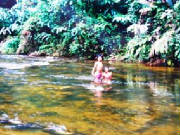
Cool fresh and clear
The undated photo above show us how refreshing Kinta
River sometimes ago with a high volume cold water streaming down beneath
lush and green tropical forest. It was something that will never spare for the next generation.
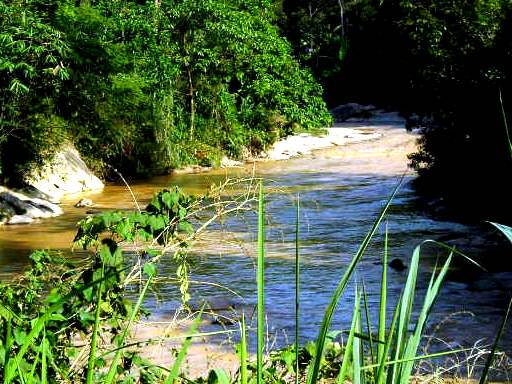
Warm and murky
Today Kinta
River, with its murky flows drove off the tourist. Thank you for the
Greater Ipoh water supply plan that initiated to ensure Ipohite accessed with sufficient clean treated water supply. The Ulu
Kinta Dam that now completed are the main cause of the declining water quality after the Simpang Pulai – Gua Musang
road project starts the soiled-the-water fiesta in 1997.
Migrated Out
For reasons that anyone could understand, Ipoh face
a serious migration phenomenon with annual population increment is in figure around -0.5% to 0.5%. Each family in Ipoh
regardless race, are having at least one of the family members migrated out mainly to the Klang Valley. There is a family
of 7 which 6 of them are now living and working in KL. The increment of the population much contributed by the migratory
workers that earn money from industrial labor for temporary basis. It is believed that this phenomenon worsened by the
accessibility for Ipohite head south to KL.
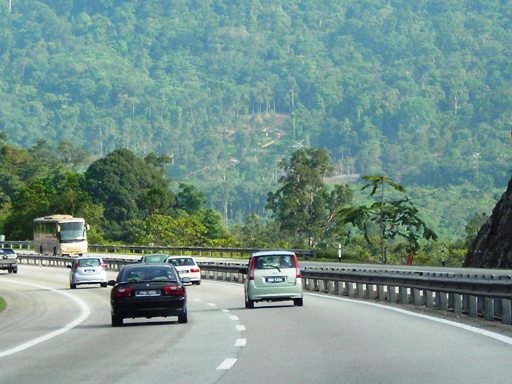
Somewhere in Gopeng
From a 5 hour driving before 1993 to a merely 2 hours
journey, KL is now considered adjacent. Because of a technical and practical reason, less of them bought properties in Ipoh
and the low demand of houses turned the city among the lowest in cost of living
Hello Foreign Workers
When there is a lifestyle shift, some job are unpopular
by the locals. To ensure the business double-fold, cheap labor are required. That was the main reason of mass recruitment
of the foreign worker that now made up 11% of Malaysia population.
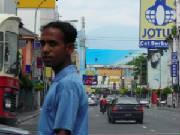
Foreign worker everywhere
This phenomenon never spared Ipoh as its target. Today, a Sunday walk around Ipoh may give a feeling like abroad. Gangs
of foreign workers flooded the city to met up with fellow countrymen and nationals doing some shopping, noise making
and strolling. As the crime rate still at the low index, most Ipohite seems having much more things to pay their attention
instead of grousing on foreign workers that now became almost 5% of the city population.
|
 |
 |
 |
|
| IPOH CITY COUNCIL |
| Hunting Line |
241 3733 |
| Hotline |
255 1515 |
| POLICE STATION |
|
| Ipoh DPH |
242 4222 |
| HOSPITAL |
|
| Ipoh GH |
253 3333 |
| WEBMASTER |
|
| ipohmalay@gmail.com |
Today, Ipoh Malay are not recgonized by its origin anymore but from the area they inhabit.
Six main corridors where some 186,100 Ipoh Malay became the major race in it is Manjoi, Tambun, Simpang Pulai,
Rapat Setia, Chemor, and Seri Kinta.
|
MALAY POPULATION |
| Corridors |
Population |
| Manjoi |
59,000 |
| Tambun |
55,000 |
| Spg. Pulai |
20,400 |
| Rapat Setia |
15,600 |
| Chemor |
13,800 |
| Seri Kinta |
12,800 |
| Others |
9,500 |
| TOTAL |
186,100 |
| Population of Ipoh |
610,000 |
| Malay Percentage |
30.51 |
Estimated 2007
Most of Malays in Ipoh are now of retirees from various states of Malaysia and their the next generation . Few of Ipoh Malay are still recgonize
themselves as Javanese ( Manjoi, Sri Kinta & Simpang Pulai ) , Baweanese ( Manjoi ) and Rawas ( Simpang Pulai ).
Below are some popular facts of Ipoh Malay :
| THE LIFE |
|
M |
F |
| Literacy |
95% |
90% |
| BM proficiency |
70% |
80% |
| English ability |
25% |
20% |
| Smoking Rate |
60% |
10% |
| Average Household
Income |
RM 3200 |
| Popular Food |
Roti canai |
| Popular Drinks |
The Tarik |
|
|
|
|
| EMPLOYMENT |
M |
F |
| Civil Servant |
35% |
30% |
| Private Sector |
15% |
25% |
| Pensioners |
20% |
5% |
| Small Business |
20% |
15% |
| Others |
10% |
25% |
|
|
|
| RELIGIOUSITY |
M |
F |
| Perfect |
45% |
35% |
| Moderate |
35% |
50% |
| Less |
20% |
15% |
|
|
|
|
| POLITICS |
M |
F |
| UMNO |
40% |
55% |
| PAS / Keadilan |
35% |
35% |
| Discreet |
25% |
10% |
|
|
|
|
| DRIVING MANEUVER |
M |
F |
| Car |
75% |
55% |
| Motorbike |
65% |
35% |
|
|
|
| TRANSPORTATION |
M |
F |
| Own Car |
30% |
15% |
| Own Motorbike |
75% |
20% |
| Public Transport |
25% |
65% |
|
|
|
| MEDIA |
M |
F |
| Daily Readers |
65% |
30% |
| Worldnews Alert |
65% |
15% |
| Ever internet |
50% |
30% |
|
|
|
|
| EXPENDITURE |
M |
F |
| Malls |
35% |
65% |
| Night Markets |
40% |
70% |
| Sundries |
30% |
70% |
|
|
|
|
| NET COMMUNITY |
M |
F |
| 7 - 18 years old |
40% |
35% |
| 19 - 40 years old |
65% |
65% |
| Above 40 years old |
40% |
30% |
Tectonically, Peninsular Malaysia forms
part of the Sunda Shield. Its Triassic fold-mountain belt, the spine of the Peninsula, continues from eastern Burma
through Thailand, Peninsular Malaysia, the Bingka and Belitung Islands, and eastwards into Indonesian
Borneo. All the systems, ranging from the Cambrian to the Quaternary, are represented in Peninsular Malaysia. The Triassic
and older strata are essentially marine whereas the post- Triassic rocks are characteristically non-marine. Sedimentation
was continuous throughout the Palaeozoic and Mesozoic. Because of the instability of the basin major breaks are apparent within
and between the Palaeozoic, Mesozoic, and Cainozoic groups of rocks. Granitoids occupy almost half the peninsula, commonly
forming topographic highs, notably in the Main Range. The main episode of granitic emplacement coincides with the culminating late
Triassic orogenic event during which all the older strata were folded and deformed.
Malaysian Geology ,
www.mymalaysia.net.my
2005
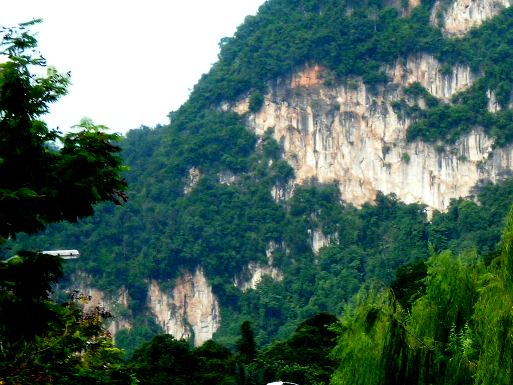
Limestones in Tambun
In Kinta Hills area, marble quartzite,
schist and argillite have been intruded by coarse-grained porphyritic biotite granite. At the margin of masses of the coarse-grained
porphyritic biotite granite are zone of medium- to fine-grained granite and leucogranite. Veins of quartz occur as fracture
fillings. Accompanying the emplacement of the leucogranite and quartz bodies were primary mineralizations of tin, tungsten
and iron which are of economic importance in the region. Deep tropical weathering has produced a thick soil cover over most
of the area.
A geochemical programme of soil, stream
and rock sampling was undertaken to search for eluvial tin deposits in the area. It resulted in the delineation of eluvial
concentrations of tin in the soil
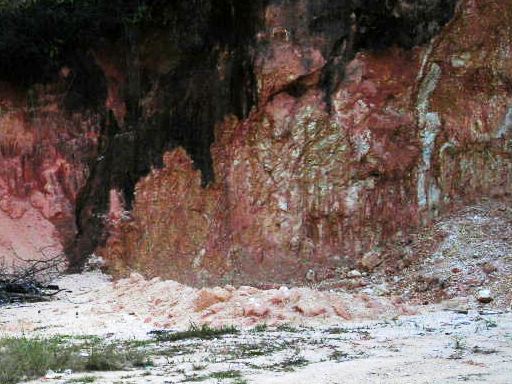
Eroded by human activity
The tin-anomalous
zones are found to form a pattern very closely associated with directions of major fractures which are most probably the conduits
of the mineralizing solutions. The tin concentration are also most prominent
in soils over vein quartz and leucogranite which are much younger than the coarse-grained granite. Tin values in soils over
the coarse-grained granite are low. Therefore it appears that tin mineralization is not disseminated in the coarse-grained
granite but is mainly associated with vein quartz and leucogranite
Unaltered biotite granites contain trace
amounts of tin and they are clearly insignificant contributors to the rich placer deposits of the Kinta Valley, which must be largely derived
from the visibly altered and mineralized rocks.
Choy Kam Wai - Geology Society
Malaysia, Bulletin 9, November, 1977; pp.233 - 252
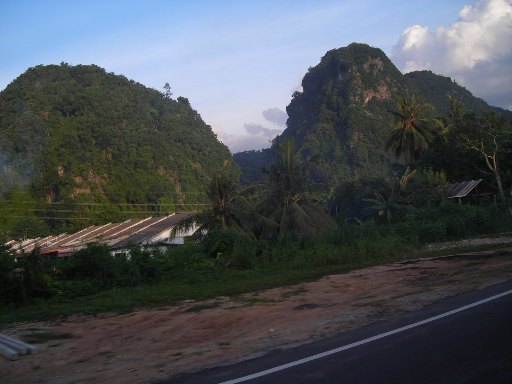
Formation in Tambun
The Titiwangsa
Range experience more impact from the tectonic activity at Sunda Trench especially
at the northern part in west Sumatra. This activity continuously happens and creates the
Peninsula Malay landscape. But a massive move from excessive submission are something that should not be ruled out. Impact
from asteroids that hits the Hindi Ocean
seabed could also be a single day disastrous earth making.
The Webmaster
About 45km driving distance to the North East of Ipoh, Sungai Korbu is
the best place to get the rain forest tranquility refreshment from clean crystal clear river that flowing down from Titiwangsa
Range via Sungai Korbu Water Catchment Area.
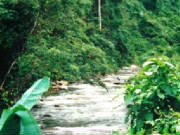
The stram located in Jalong, was accessible with premixed lane and crossing
a unique Orang Asli settlement. The river was so cold and the scenic view of the forest is too much to expressed by words.
Visit Sungai Korbu today and feel the past that preserved as our natural heritage.
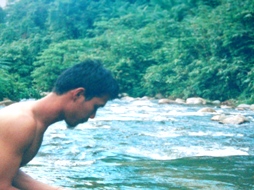
Note:
Please show some respect to the locals in the Orang Asli village as they do not welcomes outsiders that never know
how to behave in their territory.
|
 |
|
|
|
